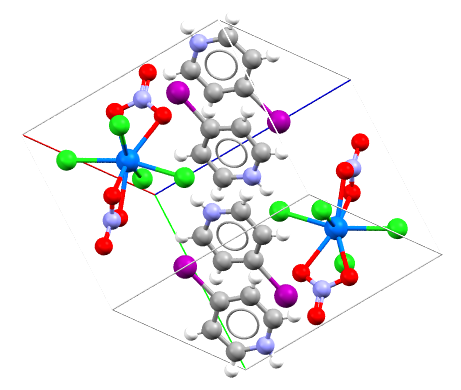Plutonium
Plutonium:
“Fat Man” was the code name for the atomic bomb dropped over Nagasaki, Japan by the United States on August 9th, 1945. The “Fat Man” contained a solid Plutonium core.
Facts about Plutonium:
- Plutonium: Plutonium is a radioactive, silvery-gray metal that tarnishes in air to give a yellow oxide coating.
- Fun fact about Plutonium: Plutonium was named after the planet, Pluto. This is because it was discovered after Uranium and Neptunium, which were named after Uranus and Neptune, respectively.
- Chemical symbol: Pu
- Atomic number: 94
A crystal structure containing Plutonium:

One of the four new [Pu(IV)Cln(NO3)6-n]2- containing materials. It was crystallized from acidic, aqueous media and structurally characterized.
Facts about this structure:
- Formula: [Cl4 N2 O6 Pu]2-, 2(C5 H5 I N +)
- Structure name: bis(4-iodo-pyridinium) dinitrato-tetrachloro-plutonium(iv)
- Fun fact about the structure: The Pu–NO3 and –Cl bonds were probed using QTAIM and NLMO analyses and found to be polar and largely ionic.
- CSD refcode: AGOLAM (What’s this?)
- Associated publication: Robert G. Surbella, Lucas C. Ducati, Jochen Autschbach, Kristi L. Pellegrini, Bruce K. McNamara, Jon M. Schwantes, Christopher L. Cahill, Chemical Communications, 2018, 54, 12014, DOI: 10.1039/C8CC05578E
More about Plutonium:
Plutonium was first made in December 1940 at Berkeley, California, by Glenn Seaborg, Arthur Wahl, Joseph Kennedy, and Edwin McMillan. They produced it by bombarding uranium-238 with deuterium nuclei (alpha particles). This first produced neptunium-238 with a half-life of two days, and this decayed by beta emission to form element 94 (Plutonium). Plutonium was used in several of the first atomic bombs, the most infamous being the “Fat Man” bomb dropped on Nagasaki, Japan, in 1945. Although Plutonium was used as a weapon for destruction, Plutonium is also a key material in the development of nuclear power. It has been used as a source of energy on space missions, such as the Mars Curiosity Rover and the New Horizons spacecraft on its way to Pluto.
Learn More About the International Year of the Periodic Table (IYPT) in Crystals Project:
This project (#IYPTCrystals) is part of the International Year of the Periodic Table celebration (#IYPT2019), read more about the project here.
You can follow us on social media; search for #IYPTCrystals or follow The CCDC on X @ccdc_cambridge on Facebook ccdc.cambridge, on Instagram ccdc_cambridge or on YouTube CCDCCambridge.
Understand some of the terms and concepts used with our Frequently Asked Questions page here.
A 3D visualization showing Plutonium in real crystal structures:
